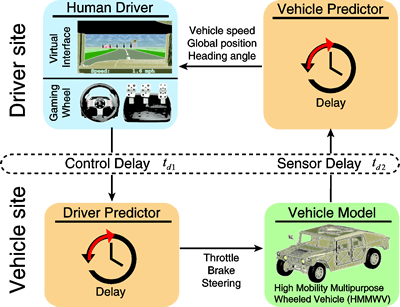Vehicle Controls & Behaviors
Annual PlanImproving Mobility through Latency Compensation in Teleoperated Ground Vehicles
Project Team
Government
Paramsothy Jayakumar, Mark Brudnak, U.S. Army GVSC
Faculty
Jeffrey Stein, University of Michigan
Industry
Mitchell Rohde, Steve M. Rohde, Quantum Signal LLC
Student
Xinyi Ge, Yingshi Zheng, University of Michigan
Project Summary
Project began in 2014 and was completed in 2017.

Unmanned Ground Vehicles (UGVs) can be operated in different modes of operation ranging from teleoperated vehicles without any autonomy to vehicles with full autonomy. At the moment, all UGVs in the Army are teleoperated; therefore, this project’s scope was teleoperated vehicles, as well. One important challenge with teleoperated vehicles is that the communication delays can negatively affect the vehicle mobility.
The overarching research objective of this project was to develop a predictor framework to compensate for the negative impact of communication latencies on mobility in teleoperated vehicles. The key feature that this predictor framework was desired to possess was to require minimal information about the system dynamics. The motivation for this requirement was to enable a solution that is as platform independent as possible and thus can be readily applied to different types of vehicles and drivers with minimal tuning.
The project delivered a novel predictor framework that can improve human drivers’ ability to teleoperate a large, high-speed UGV fast and accurately even under large communication delays. This framework offers two modes of operation: a completely model-free version for maximum robustness to modeling errors, and a blended architecture that offers a combination of the model-free predictors with a simple steering model to allow the user balance the robustness of the model-free predictors with the performance of the steering-model-based solution. Human subject experiments showed that this novel framework reduces track completion time, track keeping error, and steering effort by around 50% or more.
This project leveraged driver models and vehicle models that developed in related ARC projects.
Publications:
- X. Ge, Y. Zheng, M. J. Brudnak, P. Jayakumar, J. L. Stein, and T. Ersal, “Performance Analysis of a Model-Free Predictor for Delay Compensation in Networked Systems,” IFAC Workshop on Time Delay Systems, Ann Arbor, MI, 2015.
- X. Ge, M. J. Brudnak, P. Jayakumar, J. L. Stein, and T. Ersal, “A model-free predictor framework for tele-operated vehicles,” American Control Conference, Chicago, IL, 2015.
- Y. Zheng, M. J. Brudnak, P. Jayakumar, J. L. Stein, and T. Ersal, “An Experimental Evaluation of a Model-Free Predictor Framework in Teleoperated Vehicles,” IFAC Workshop on Time Delay Systems, Istanbul, Turkey, 2016.
- X. Ge, Y. Zheng, M. J. Brudnak, P. Jayakumar, J. L. Stein and T. Ersal, “Anaylsis of a Model-Free Predictor for Delay Compensation in Networked Systems, " in Time-Delay Systems - Theory, Numerics, Applications and Experiments, vol. 7, Advances in Delays and Dynamics, T. Insperger, T. Ersal and G. Orosz, Eds.: Springer, 2017
- S. Lu, M. Y. Zhang, T. Ersal, and X. J. Yang, “Effects of a Delay Compensation Aid on Teleoperation of Unmanned Ground Vehicles,” Human-Robot Interaction, Chicago, IL, 2018.
- Y. Zheng, M. J. Brudnak, P. Jayakumar, J. L. Stein and T. Ersal, “A Predictor-Based Framework for Delay Compensation in Networked Closed-Loop Systems,” in IEEE/ASME Transactions on Mechatronics, vol. 23, no. 5, pp. 2482-2493, Oct. 2018, doi: 10.1109/TMECH.2018.2864722.
- X. Ge, Y. Zheng, M. J. Brudnak, P. Jayakumar, J. L. Stein, and T. Ersal, “Performance Analysis of a Model-Free Predictor for Delay Compensation towards Tele-Operated Vehicles,” IFAC-PapersOnLine, vol. 48, no. 12, pp. 434-439, 2015. doi:10.1016/j.ifacol.2015.09.417
- Y. Zheng, M. J. Brudnak, P. Jayakumar, J. L. Stein and T. Ersal, “A Delay Compensation Framework for Predicting Heading in Teleoperated Ground Vehicles,” in IEEE/ASME Transactions on Mechatronics, vol. 24, no. 5, pp. 2365-2376, Oct. 2019, doi: 10.1109/TMECH.2019.2936313.
#1.17
Publications:
Ge X., Zheng Y., Brudnak M.J., Jayakumar P., Stein J.L., Ersal T. (2017) Analysis of a Model-Free Predictor for Delay Compensation in Networked Systems. In: Insperger T., Ersal T., Orosz G. (eds) Time Delay Systems. Advances in Delays and Dynamics, vol 7. Springer, Cham.
X. Ge, Y. Zheng, M. J. Brudnak, P. Jayakumar, J. L. Stein, and T. Ersal, “Performance Analysis of a Model-Free Predictor for Delay Compensation in Networked Systems”, IFAC Workshop on Time Delay Systems, Volume 48, Issue 12, 2015, Pages 434–439, Ann Arbor, MI, 2015.
X. Ge, M. J. Brudnak, P. Jayakumar, J. L. Stein, and T. Ersal, “A model-free predictor framework for tele-operated vehicles”, American Control Conference, Pages 4573 - 4578, Chicago, IL, 2015.
Y. Zheng, M. J. Brudnak, P. Jayakumar, J. L. Stein, and T. Ersal, “An Experimental Evaluation of a Model-Free Predictor Framework in Teleoperated Vehicles,” IFAC Workshop on Time Delay Systems, Istanbul, Turkey, 2016.
Y. Zheng, M. J. Brudnak, P. Jayakumar, J. L. Stein, and T. Ersal, “A Predictor Based Framework for Delay Compensation in Networked Closed-Loop Systems,” IEEE/ASME Transactions on Mechatronics, vol. 23, no. 5, pp. 2482-2493, 2018.
Y. Zheng, M. Brudnak, P. Jayakumar, J. L. Stein, and T. Ersal, “A Delay Compensation Framework for Predicting Heading in Teleoperated Ground Vehicles,” IEEE/ASME Transactions on Mechatronics, vol. 24, no. 5, pp. 2365-2376, 2019.
Y. Zheng, M. Brudnak, P. Jayakumar, J. L. Stein, and T. Ersal, “An Experimental Evaluation of a Predictor Based Framework in High-Speed Teleoperated UGVs,” IEEE Transactions on Human-Machine Systems, in press.

